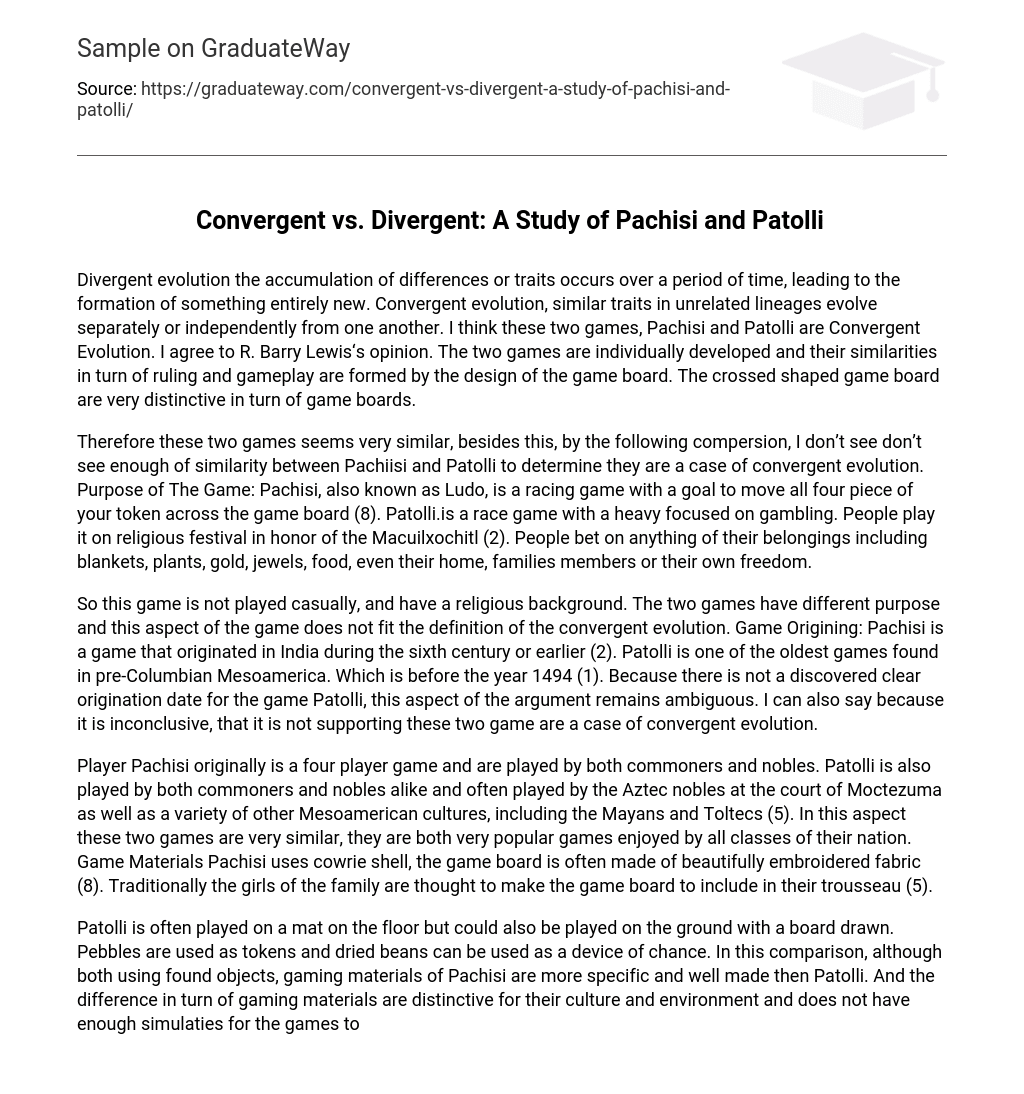Divergent evolution the accumulation of differences or traits occurs over a period of time, leading to the formation of something entirely new. Convergent evolution, similar traits in unrelated lineages evolve separately or independently from one another. I think these two games, Pachisi and Patolli are Convergent Evolution. I agree to R. Barry Lewis‘s opinion. The two games are individually developed and their similarities in turn of ruling and gameplay are formed by the design of the game board. The crossed shaped game board are very distinctive in turn of game boards.
Therefore these two games seems very similar, besides this, by the following compersion, I don’t see don’t see enough of similarity between Pachiisi and Patolli to determine they are a case of convergent evolution. Purpose of The Game: Pachisi, also known as Ludo, is a racing game with a goal to move all four piece of your token across the game board (8). Patolli.is a race game with a heavy focused on gambling. People play it on religious festival in honor of the Macuilxochitl (2). People bet on anything of their belongings including blankets, plants, gold, jewels, food, even their home, families members or their own freedom.
So this game is not played casually, and have a religious background. The two games have different purpose and this aspect of the game does not fit the definition of the convergent evolution. Game Origining: Pachisi is a game that originated in India during the sixth century or earlier (2). Patolli is one of the oldest games found in pre-Columbian Mesoamerica. Which is before the year 1494 (1). Because there is not a discovered clear origination date for the game Patolli, this aspect of the argument remains ambiguous. I can also say because it is inconclusive, that it is not supporting these two game are a case of convergent evolution.
Player Pachisi originally is a four player game and are played by both commoners and nobles. Patolli is also played by both commoners and nobles alike and often played by the Aztec nobles at the court of Moctezuma as well as a variety of other Mesoamerican cultures, including the Mayans and Toltecs (5). In this aspect these two games are very similar, they are both very popular games enjoyed by all classes of their nation. Game Materials Pachisi uses cowrie shell, the game board is often made of beautifully embroidered fabric (8). Traditionally the girls of the family are thought to make the game board to include in their trousseau (5).
Patolli is often played on a mat on the floor but could also be played on the ground with a board drawn. Pebbles are used as tokens and dried beans can be used as a device of chance. In this comparison, although both using found objects, gaming materials of Pachisi are more specific and well made then Patolli. And the difference in turn of gaming materials are distinctive for their culture and environment and does not have enough simulaties for the games to be convergent evolution.
Game Board Design Pachisi is played on a cross-shaped board with four wings each contains three rows that connected in the middle. Eech wings have squared ends (5). Patolli board also have four wings each marked with sixty or seventy places for the pebbles. The four wings are connected in the middle. Each wing contains two rows and have a rounded end (6). The overall shape of the game board of these two games are very similar. And because not a lot of board games contains a cross-shaped board, these two stands out as being alike to each other. However cross as an symbol is very common in human history.
The most commonly known ones as the Christian Cross Symbols, the Greek Cross, the Buddhist Swastika the Swiss national flag also have a cross (9). The board shape along is not enough evidence to prove that the Pachisi and Patolli are convergent evolution. Rules, Mechanics, and Gameplay The game play of Pachisi, each player races trying to take their four tokens around and off the board before their opponents. Patolli each player has six tokens in representing the six of their items. Upon the completion the circuits around the board of each tag, one player transfers one item’s ownership to the other player.





